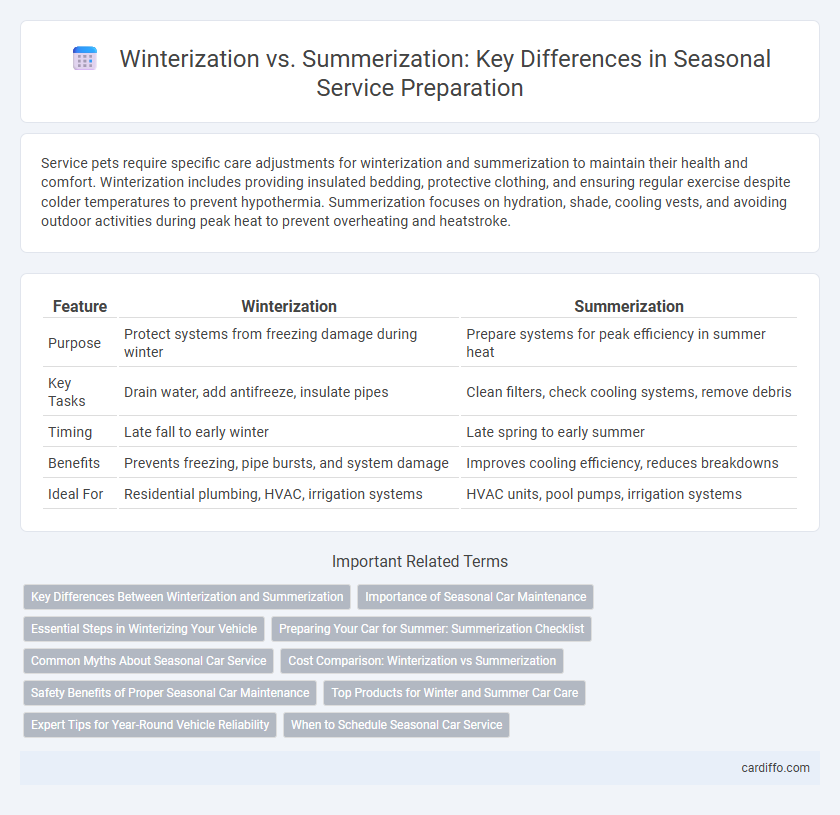Service pets require specific care adjustments for winterization and summerization to maintain their health and comfort. Winterization includes providing insulated bedding, protective clothing, and ensuring regular exercise despite colder temperatures to prevent hypothermia. Summerization focuses on hydration, shade, cooling vests, and avoiding outdoor activities during peak heat to prevent overheating and heatstroke.
Table of Comparison
| Feature | Winterization | Summerization |
|---|---|---|
| Purpose | Protect systems from freezing damage during winter | Prepare systems for peak efficiency in summer heat |
| Key Tasks | Drain water, add antifreeze, insulate pipes | Clean filters, check cooling systems, remove debris |
| Timing | Late fall to early winter | Late spring to early summer |
| Benefits | Prevents freezing, pipe bursts, and system damage | Improves cooling efficiency, reduces breakdowns |
| Ideal For | Residential plumbing, HVAC, irrigation systems | HVAC units, pool pumps, irrigation systems |
Key Differences Between Winterization and Summerization
Winterization involves preparing systems, such as HVAC or plumbing, to withstand freezing temperatures by insulating pipes and draining water to prevent damage. Summerization focuses on optimizing equipment performance for warmer weather, including cleaning, lubricating, and inspecting cooling systems like air conditioners. The key difference lies in winterization preventing cold-related damage, while summerization enhances efficiency and comfort during hot conditions.
Importance of Seasonal Car Maintenance
Seasonal car maintenance is crucial for optimizing vehicle performance and safety, with winterization preventing engine freeze and enhancing battery efficiency in cold temperatures. Summerization protects against overheating by ensuring the cooling system functions properly and checking tire pressure for better road grip. Regular seasonal service extends vehicle lifespan and reduces costly repairs caused by extreme weather conditions.
Essential Steps in Winterizing Your Vehicle
Winterizing your vehicle requires essential steps such as checking and replacing antifreeze, testing the battery, and inspecting tires for proper tread and pressure to ensure performance in cold conditions. Draining and replacing windshield washer fluid with a winter formula prevents freezing, while ensuring the heater and defroster are functioning optimally is critical for safety. Skipping these winterization steps can lead to mechanical failures, reduced fuel efficiency, and increased risk of accidents on icy roads.
Preparing Your Car for Summer: Summerization Checklist
Preparing your car for summer involves a thorough summerization checklist that includes checking and replacing the coolant to prevent overheating, inspecting the air conditioning system for optimal performance, and ensuring tires are properly inflated and have sufficient tread for safe driving. Changing to summer-grade oil improves engine efficiency in higher temperatures while inspecting belts and hoses prevents breakdowns caused by heat-related wear. Regularly cleaning and protecting the exterior with a quality wax maintains paint integrity and shields against sun damage during the hot months.
Common Myths About Seasonal Car Service
Many vehicle owners mistakenly believe winterization only involves antifreeze checks and tire changes, while ignoring comprehensive fluid replacements and battery tests critical for cold weather performance. Summerization is often reduced to air conditioning servicing, yet neglecting coolant system maintenance and tire pressure adjustments can lead to overheating and inefficient fuel consumption. Proper seasonal car service requires a full inspection tailored to temperature fluctuations, debunking myths that limit preparation to a single component.
Cost Comparison: Winterization vs Summerization
Winterization services typically incur higher costs due to the need for extensive preparation against freezing temperatures, including insulation and drainage measures, which can range from $150 to $500 depending on the property size. Summerization tends to be less expensive, generally costing between $100 and $300, focusing mainly on HVAC tuning, debris removal, and system checks to ensure optimal cooling efficiency. Comparing these services reveals winterization demands greater labor and materials, leading to increased expenses relative to summerization tasks.
Safety Benefits of Proper Seasonal Car Maintenance
Proper seasonal car maintenance through winterization and summerization significantly enhances vehicle safety by ensuring optimal performance in extreme temperatures. Winterization protects critical systems such as brakes, tires, and batteries from freezing conditions, reducing the risk of accidents due to ice or snow. Summerization ensures cooling systems and air conditioning operate efficiently, preventing engine overheating and maintaining clear visibility for safer driving.
Top Products for Winter and Summer Car Care
Top products for winter car care include antifreeze coolant, heavy-duty windshield washer fluid, and all-weather floor mats designed to withstand snow and mud. For summer car maintenance, UV protectant sprays, high-performance engine oils optimized for heat, and radiator coolants formulated to prevent overheating are essential. Selecting season-specific automotive products enhances vehicle performance, safety, and longevity during extreme temperature fluctuations.
Expert Tips for Year-Round Vehicle Reliability
Winterization involves preparing your vehicle for cold temperatures by using antifreeze, checking battery health, and switching to winter tires to enhance traction on icy roads. Summerization focuses on maintaining optimal engine cooling, inspecting air conditioning systems, and using summer-grade motor oil to prevent overheating and ensure efficient performance. Following expert tips on seasonal maintenance boosts year-round vehicle reliability and reduces the risk of breakdowns in extreme weather conditions.
When to Schedule Seasonal Car Service
Schedule winterization service in early fall to ensure your vehicle is prepared for cold temperatures, icy roads, and shorter daylight hours, preventing battery failure and fluid freezing. Summerization is best done in late spring to optimize cooling systems, check tire pressure, and enhance air conditioning efficiency for hot weather driving. Timely seasonal servicing extends vehicle lifespan, improves safety, and maintains peak performance throughout temperature fluctuations.
Winterization vs Summerization Infographic

 cardiffo.com
cardiffo.com